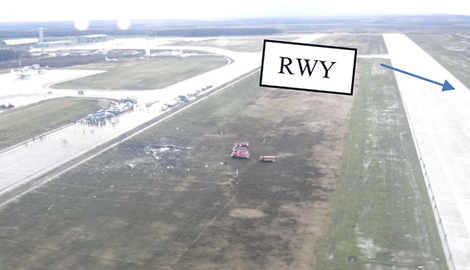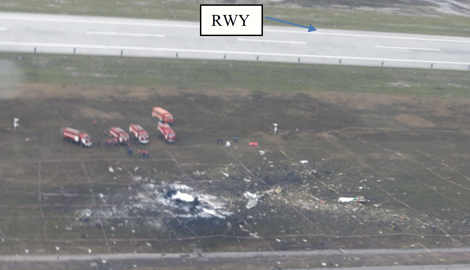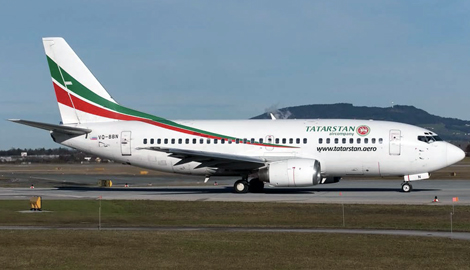Tatarstan Airlines flight TAK363 was a commercial flight operated on November 17, 2013 from Moscow (Domodedovo, UUDD) to Kazan (UWKD) on the Boeing 737-500 VQ-BBN aircraft.
At 10:10 all the crew members passed medical examination at Kazan airport medical post and the record was made in the flight task. There were no comments concerning their health status. After the medical control the crew members commenced performing their duties in accordance with the working procedure.

Tatarstan Airlines flight TAK363
The departure of Tatarstan Airlines flight TAK363 from Moscow to Kazan was performed at 14:25, on schedule. Besides 2 flight crew members, there were 4 cabin crew members and 44 passengers on board; 50 people in all, including 48 citizens of the Russian Federation, 1 citizen of United Kingdom, 1 citizen of Ukraine.
In accordance with the documentation provided, the commercial load of Tatarstan Airlines flight TAK363 was 4047 kg, there was no cargo prohibited for air transportation on board. Takeoff fuel weight was 7800 kg, which was enough for performing the flight according to the planned route considering the standby airport chosen.
At 15:12:35 the aircraft crew of Tatarstan Airlines flight TAK363 was commanded by the Kazan – Radar controller: “Tatarstan 363, Kazan – Radar, good evening, cleared for ILS, RWY29, QFE 980, descend to 500 m”. The crew acknowledged the information.
At 15:18:00 the aircraft crew reported: “Tatarstan 3-6-3, turning base, 500”, to which they were commanded: “Tatarstan 363, make base-to-final (turn)”.
The actual point where the turn of Tatarstan Airlines flight TAK363 was started deviated significantly from the turning point assigned by the approach pattern (the aircraft was “inside” the assigned circuit).
At 15:21:34 the controller advised: “Tatarstan 363, wind 220 degrees at 9 meters per second gusting 12, RWY29, cleared to land”. At 15:21:41 the crew acknowledged: “Cleared to land, Tatarstan 363”.
At 15:22:41 the crew reported going around due to non-landing position: “Tatarstan 363, going around, non-landing position”.

Tatarstan Airlines flight TAK363
At that moment, the aircraft was at a distance of approximately 1 km from the runway threshold, almost on the final approach path, at the constant height of approximately 270 m (approximately 900 ft) above the aerodrome level.
While going around, after climbing approximately 700 m (approximately 2300 ft) above the aerodrome level, Tatarstan Airlines flight TAK363 pitched nose down and impacted the ground at a great speed (approximately 450 km/h) and a big negative pitch angle (approximately 75°).
From the start of go-around and till the end of the recording, approximately 43 sec passed. As a result of impacting the ground, the passengers and crew members who were on board died, the aircraft was completely destroyed and was partially burned in the postcrash fire.
The air accident occurred at 15:23:28, at the territory of Kazan airport, between the runway, main taxiway, taxiway C and taxiway B. The elevation of the accident site is 115 m above sea level.
Some of the findings and cause of the event :
- After descending to 270 m (900 ft) the FO found, after he saw the runway and PAPI lights, that the aircraft’s position was unsuitable for landing and it was he who initiated the decision to go around ;
- The PIC agreed with that decision immediately.
- The crew took a correct decision to go around (though it was delayed)
- After the go-around decision, the PIC asked the FO to make a relative report to the ATC, by which he cancelled his own instruction given during the landing briefing to report to the ATC only after completing the go-around maneuver.
- After the FO was instructed to report to the ATC on the go-around, he communicated for 20 seconds (16 seconds from the moment when TO/GA pushbutton had been pressed) with the controller and did not perform the PNF duties.
- The flap retraction to Flaps 15 command called out by the PIC right after the go-around start, was most probably performed by the PIC on his own.
- Due to the thrust increase and flaps retraction from Flaps 30 to Flaps 15, there was a nose up pitching moment that resulted in pitch angle increase and positive vertical speed.
- Within 25 seconds after the start of the go-around there were almost no column or wheel inputs.
- As there were no control inputs, 20 seconds after the start of the go-around the pitch increased to over 25 degrees, the airspeed was decreasing (the minimum speed of 117 kt was recorded 30 seconds after the go-around has been initiated).
- The PIC took control of the aircraft only 25 seconds after the go-around had been initiated. He pushed the column nose down for about 1/3 of the travelling distance.
- The third nose down column input produced by the PIC confirmed his spatial disorientation as well as disintegration and critical tunnelling of his flight perception. In the current circumstances the PIC could also have experienced somatogravic nose up pitching illusion.
- The crew did not react to the EGPWS alerts (SINK RATE – PULL UP), though the alerts were triggered in due time as per design.
- Such control input resulted in 0.8 to 0.9 g negative vertical load and the pitch angle reaching 55 to 60 degrees nose down.
- The abnormal situation turned into an emergency. Further control actions were chaotic.
- The aircraft impacted the ground with a high speed (over 450 km/h) and large nose up pitch angle (approx. 75 degrees).
Contributory factors :
- lack of due oversight system over personnel licensing, compliance of pilots with qualification requirements and granting of various ratings;
- inoperability of SMS in airlines, lack of guidance on their development and approval, a nominal approach of the accredited authorities to the approval/acceptance of SMS and flight crew training programs;
- imperfectness of aviation training organizations operation and actual lack of control over the results of type rating training;
- no requirements to flight crews as to the ELP as appropriate to undertake type rating training for foreign-made aircraft and nominal approach to the ELP assessment;
- nominal approach to recurrent and qualification checks of flight crews;
- systemic violations of duty and rest time limitations;
- insufficient training of flight crews with respect to go-arounds from intermittent heights, manual flying and upset recovery;
- map shift effect appearing on aircraft not equipped with GPS and insufficient training of flight crew with regard to flight conduct with map shift;
- lack of active assistance to the flight crew from the ATC when the latter detected significant long-term deviations from the standard patterns;
- violation of the Aviate – Navigate – Communicate concept.
Download Report


0 Comments